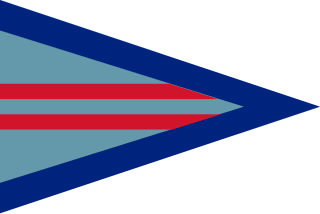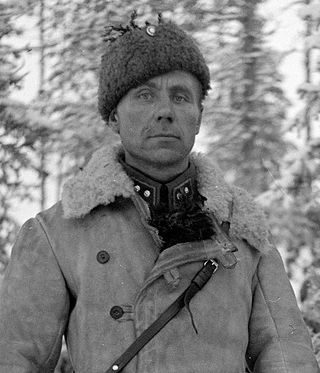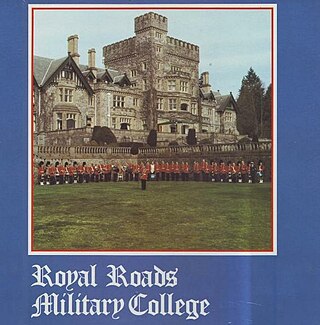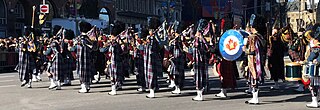
A military band is a group of personnel that performs musical duties for military functions, usually for the armed forces. A typical military band consists mostly of wind and percussion instruments. The conductor of a band commonly bears the title of Bandmaster or Music director. Ottoman military bands are thought to be the oldest variety of military marching bands in the world, dating from the 13th century.
This is a table of the ranks and insignia of the Canadian Armed Forces. As the Canadian Armed Forces is officially bilingual, the French language ranks are presented following the English.
Canadian Forces Base Borden, formerly RCAF Station Borden, is a large Canadian Forces base located in Ontario. The historic birthplace of the Royal Canadian Air Force, CFB Borden is home to the largest training wing in the Canadian Armed Forces. The base is run by Canadian Forces Support Training Group (CFSTG) and reports to the Canadian Defence Academy (CDA) in Kingston.
Flying officer is a junior commissioned rank in the Royal Air Force (RAF) and the air forces of many countries which have historical British influence. It is also sometimes used as the English translation of an equivalent rank in countries which have a non-English air force-specific rank structure. In these cases a flying officer usually ranks above pilot officer and immediately below flight lieutenant.

Wing commander is a senior commissioned rank in the British Royal Air Force and air forces of many countries which have historical British influence, including many Commonwealth countries but not including Canada and South Africa. It is sometimes used as the English translation of an equivalent rank in countries which have a non-English air force-specific rank structure. It ranks immediately above squadron leader and immediately below group captain.

Air Chief Marshal Lloyd Samuel Breadner, CB, DSC was a Canadian military pilot and Chief of the Air Staff during World War II.

The Royal Canadian Air Force is the air and space force of Canada. Its role is to "provide the Canadian Forces with relevant, responsive and effective airpower". The RCAF is one of three environmental commands within the unified Canadian Armed Forces. As of 2020, the Royal Canadian Air Force consists of 12,074 Regular Force and 1,969 Primary Reserve personnel, supported by 1,518 civilians, and operates 258 manned aircraft and nine unmanned aerial vehicles. Lieutenant-General Eric Kenny is the current commander of the Royal Canadian Air Force and chief of the Air Force Staff.

438 "City of Montreal" Tactical Helicopter Squadron is a unit of the Royal Canadian Air Force. The squadron operates the Bell CH-146 Griffon tactical helicopter from the Hartland de Montarville Molson Hangar of CFB St. Hubert in Quebec, Canada. Its tasks include armed and unarmed tactical utility transport, training aircrew personnel in basic and advanced aviation tactics, technical training of groundcrew personnel and flight engineers and the periodic maintenance of CH-146 fleet aircraft. They also include as residual capabilities search and rescue, reconnaissance and support to federal, provincial and local law enforcement agencies. A "total force" unit composed of members of the Regular Force, and both full time and part time reservists, the squadron is part of 1 Wing at CFB Kingston Ontario.

The Royal Winnipeg Rifles are a Primary Reserve one-battalion infantry regiment of the Canadian Army. Nicknamed the "Little Black Devils", they are based at Minto Armoury in Winnipeg, Manitoba. The Royal Winnipeg Rifles are part of 3rd Canadian Division's 38 Canadian Brigade Group.

The "Royal Air Force March Past" is the official march of the Royal Air Force (RAF) and is used in some other Commonwealth air forces.

The Music Branch is a personnel branch of the Canadian Armed Forces (CAF). It is primarily composed of band musicians, and also deals with the selection and musical training of its recruits. The branch encompasses all the military bands in service in the Canadian Armed Forces. It is roughly the equivalent to the British Army's Royal Corps of Army Music (CAMUS).

The army rank of captain is a commissioned officer rank historically corresponding to the command of a company of soldiers. The rank is also used by some air forces and marine forces, but usually refers to a more senior officer. Today, a captain is typically either the commander or second-in-command of a company or artillery battery. In the Chinese People's Liberation Army, a captain may also command a company, or be the second-in-command of a battalion.

The Royal Canadian Artillery Band is one of six Regular Force bands in the Canadian Armed Forces. Located at Canadian Forces Base Edmonton, the RCA Band provides music designed to support Canadian Forces operations, foster morale and esprit de corps, and promote Canada and the Canadian military nationally and abroad. The band operates mainly in western Canada and is de facto the representative band of the Canadian Army in the western provinces. All unit members are professional musicians in addition to being members of the military, which enables the band to adopt a variety of configurations to suit the musical needs of their audiences. Ensembles can range from jazz combos, rock bands, and chamber groups, through stage and show bands to full marching and concert bands.

Canadian military bands are a group of personnel in the Canadian Armed Forces (CAF) that performs musical duties for military functions. Military bands form a part of the Music Branch of the CAF, composed of six full-time professional Regular Force bands, 15 Regular Force voluntary bands, and 53 part-time reserve force bands. Bands of the Music Branch are often badged with the unit or Canadian Forces base insignia that they support.

The Central Band of the Canadian Armed Forces is one of six full-time Regular Force military bands in the Canadian Armed Forces. It is also the seniormost military band in the CAF. The band provides professional musical support for the representative institutions of the Canadian Forces, supporting the Department of National Defence and the Government of Canada, in events throughout the National Capital Region.

The Indian military bands consists of musicians from the Indian Army, Navy and Air Force. Indian military bands regularly participate in international festivals and take part in celebrations dedicated to various national events. These bands are permanent participants in the Delhi Republic Day parade on the Rajpath. Today, the Indian Armed Forces have more than 50 military brass bands and 400 pipe bands and corps of drums. A Tri-Services Band refers to a joint Indian Armed Forces military band that performs together as a unit. At the Spasskaya Tower Military Music Festival and Tattoo in Moscow, the band consisted of 7 officers and 55 musicians. The Military Music Wing of the Army Education Corps is the principal educational institution of the armed forces that provides instruction to musicians of all ranks. Instruction is also provided by the Military Music Training Center and the Indian Navy School of Music.
The 22 Wing Band is a military band of the Royal Canadian Air Force. The band is currently based at CFB North Bay in Ontario. It was formed between 1989 and 1990 primarily to support ceremonial functions at the base. Its founder, then-Warrant Officer Chip Kean recruited 25 local civilian musicians to join the newly sanctioned band which designated Kean as its first official bandmaster. Jean retired in 1995, however, returned in 1998 as part of the Air Reserve due to the danger of the band being disbanded by the Department of National Defence.

The Royal Roads Military College Band was the college military marching band for the Royal Roads Military College in Hatley Park, near Victoria, British Columbia, Canada. It was formed in 1975 after the college was 35 years old.

The Royal Canadian Air Force Pipes and Drums (RCAFPD) is a military pipe band unit composed of current members of the Royal Canadian Air Force. The unit was formally established in October 1949 and is the longest continuous serving Air Force Pipe Band in the Canadian Forces. All of its 40 members are volunteers who are drawn from both the military and civilian sphere. At the time of its foundation, it was known as the RCAF Station Rockcliffe Pipe Band.














